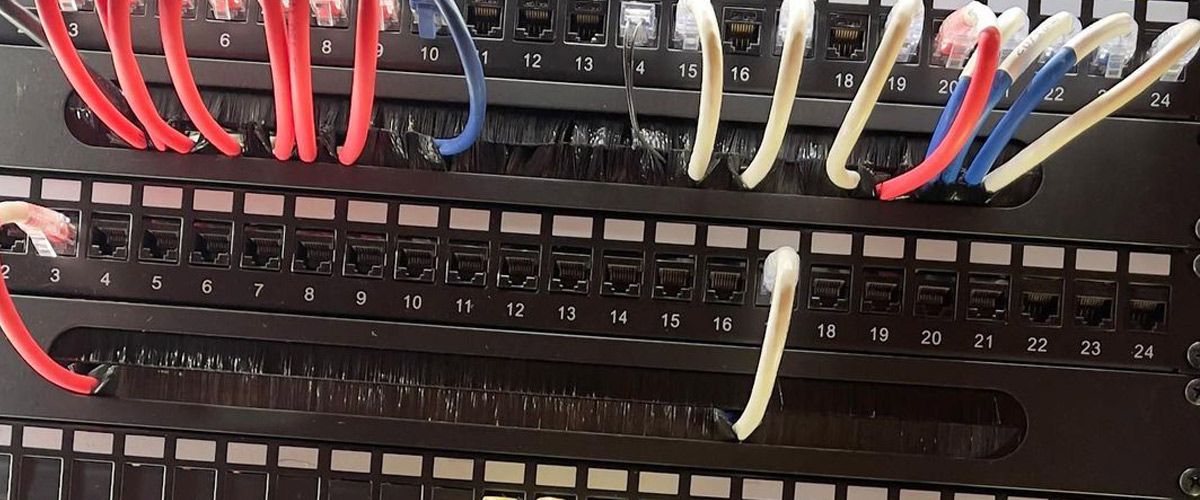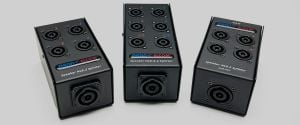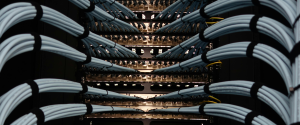Patch Panels are the cornerstone of networking infrastructure. Known for aiding organization, patch panels make it easy to manage your cabling and enhance troubleshooting.
Explore our guide uncovering the benefits of using patch panels, the types of patch panels available at Penn Elcom, as well as some tips for installing patch panels into your racking.
What is a Patch Panel?
Patch Panels are a standard rack panel punched with ports for network connectors featuring ID strips/labels to help with identification. Many network patch panels are an adaptable choice for 19 inch racks or server enclosures, giving you seamless control of connections, and allowing users to add or remove connection points easily and efficiently.
Patch Panels are used by many organizations to keep their systems structured, from large data centers and server rooms, to standard home networks or telecommunication systems.
What is the purpose of a Patch Panel?
Patch Panels create a centralized point of access in a racking unit, providing organisation and configuration. With simplified signal routing and system integration, network Patch Panels make it easy to maintain and upgrade without interrupting the entire network and ensure multiple connections work efficiently.
Benefits of Using Patch Panels
Improved Organization: Patch Panels help organize cabling by keeping them neat and structured, reducing clutter and preventing tangling of wires, which in turn improves performance.
Enhanced Network Management: The ID strips allow for quick and easy identification, labelling and color coding, alongside straight/angled ports and removable modules.
Scalable Infrastructure: Futureproof your network rack set up by allowing for simplified additions and new connections.
Cost Effective: Upgrading your system with rack mount patch panels will help to make adaptations easier, as well as minimize down time and maintenance periods.
Component Protection: Patch Panels help to absorb some of the strain on connections which can help reduce physical damage to key components.
Patch Panel Connection Types
Industries, including networking and communications, entertainment, and security, use Patch Panels. Servicing a large variety of needs, Patch Panels can use various types of cabling, including Ethernet, fiber optic or coaxial cables, amongst others. The right cabling can dictate the quality of transmission, reduce noise and crosstalk for better signal handling and even combine data and power.
When deciding on what type of connection you need when installing patch panels, you need to understand the system that you are installing…
Ethernet connections are common in network patch panels, with categories such as Cat5e (up to 1000Mbps), Cat6 (10Gbps) and Cat6a (long distance 10Gbps), all offering performance benefits depending on the requirements of your system.
Fiber Optic connections are essential for data centers and netowrk racks requiring high bandwidth and minimal signal loss.
Coaxial Patch cabling can be found in broadcast studios, digital audio or other systems using radio frequencies.
Penn Elcom offers a wide range of different cabling for patch panels. Contact us today if you are looking for something specific or need further assistance.
Our Patch Panel Connection Features
Penn Elcom produces a range of Patch Panels including:
Panel with ID Strip for 24 x Keystone Snap-in Modules
Made to fit into a standard 19-inch rack, this professional patch panel was created to fit Keystone Snap-In modular connectors that simply snap into the panel. With a built in ID strip, you can keep track of your set up with improved organization, and this patch panel can support various connector types through keystone inserts for network, AV or fiber optic connections, amongst others.
Panel Punched for 24 x Keystone Snap-in Modules with Cable Management
Similar to R1245/1UK, instead of an ID strip, it comes with a cable bar as for easier cable management.
Panel Filled with 24 x CAT 5e Connectors with Cable Management
With this model, you can save installation time and effort with an integrated cable management bar and CAT5e connectors.
Panel with ID Strip Pre-Loaded with 24 x CAT 6 Connectors
Pre-installed with CAT6 jacks, this patch panel makes it easy to install and identify your connections and can be installed easily into any standard 19 inch rack cabinet or enclosure.
How to Choose the Right Patch Panel for Your Network
You need to investigate what devices you are currently using, what you plan to use and how many connections you need to identify the best patch panels for your network and how many you'll need. You will also need to evaluate your rack enclosure's suitability and compatibility with your desired equipment, the density of your ports per patch panel, and of course, your budget.
INSTALLATION TIPS FOR PATCH PANELS
It can be simple to install Patch Panels into your rack enclosure depending on the type of network Patch Panels you are using.
First, gather all your equipment and plan the installation, from the type of rack you are going to use, the cables (measuring, cutting, and stripping the cable end etc), as well as other cable management accessories you may need like cable ties, tie bars or organisers.
Securely mount the Patch Panel into the rack or wall mount, and then insert and punch down the cables following the wiring scheme of your Patch Panel with a punch-down tool. Make sure it is properly seated and secure, cutting off excess if necessary.
Before starting to use your Patch Panel, we recommend you test your connections, organize and label your wiring.
Make sure your cables are not bundled too tightly or are at risk of twisting through sharp bends. Do not strip your cable too far, as exposing too much of the interior when connecting your wires to network points could produce an insecure connection and possible failure.
How to Maintain and Troubleshooting Patch Panels
Patch Panels can be tailored and individual to your organisation and specific needs but keeping consistent wiring standards (e.g. making sure network cables are not too long or twisted), labelling every connection and avoiding overcrowding will help to ensure that you maintain performance.
Make sure to keep regular maintenance of your equipment, with cleaning, testing and updating documentation.
Having someone responsible for regular audits, training and ordering of spare parts will help you avoid common problems such as loose connections, cable damage, incorrect wiring and port failure/signal degradation.
Patch Panels are the perfect choice to recreate organized, scalable networks across many different connection types and systems. The benefits of choosing and maintaining the right Patch Panel will help you achieve your goals, from managing the flow of data or making sure your audio signals are clear.
Patch Panels, whether using keystone snap-in modules or pre-loaded connectors, are adaptable and flexible hardware that make it easy to manage and maintain integrated network cables and enhance performance in a cost-effective way.
Explore our range of Patch Panels and cable management accessories today!














